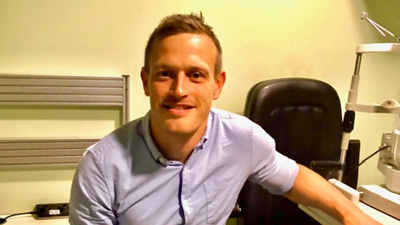- OT
- Life in practice
- Practitioner stories
- Coronavirus: on the ground in Chesterfield
On the ground
Coronavirus: on the ground in Chesterfield
Optometrist Alex Howard on the value of CUES and an increase in ischaemic problems in young patients following COVID-19

Alex Howard
03 July 2020
As the coronavirus (COVID-19) pandemic transforms the way optometrists practise, OT is sharing the experiences of optometrists across the UK and beyond. If you, or a colleague, is interested in sharing your story please get in touch by email.
I work for Primary Eye Care Services and Specsavers Chesterfield. We are based in a medium size market town just outside of Sheffield with a good mix of NHS and private work.
The effect of COVID-19 was quite quick. We were open as normal and then routine work was stopped. I am used to working in a really busy High Street practice with ten test rooms and 80 staff. During lockdown, we were running on a skeleton staff of one or two optometrists each day and support staff. We had a locked door policy and wore full personal protective equipment when we were refracting patients. Everything was done by appointment. We have a phoropter but we have a long lead so we were carrying out the refraction from more than three metres. It is a really different way of working. Optometry can become routine but the current situation has blown that out of the water.
We have a COVID 19 urgent eye care (CUES) service in place, which I feel is vital to take pressure off GPs, the hospital eye service and to make sure that patients have somewhere to be seen that is out of a high risk environment.
During lockdown, we saw a lot of ischaemic issues that we would not usually see in normal times, like anterior ischaemic optic neuropathies, central retinal artery occlusion, random unexplained visual field defects and cotton wool spots in younger patients. I feel like it is hard to know for sure whether that is because everything has been concentrated down from ten clinics into a single clinic or whether there was an increase in unusual pathology.
I guess we will find out for sure if there is a link between ischaemic eye problems and COVID-19 with time and a bit more research. A lot of the patients who present with these unusual problems do report having had COVID-19 symptoms.

This crisis has brought all of the practices together in Derbyshire in a way that I have never seen before. I don’t think we will go back to feeling divided like we were before. As much as it has been a time of hardship, there have been some positives to come out of this. I think CUES is one of them.
I think CUES is vital in the short term to meet the immediate needs of the community but also really important in the recovery phase. As we know, hospital eye services were already at capacity before this all happened and now we have a backlog of patients. The hospitals are also going to have a reduced capacity moving forward because of social distancing. I think that CUES and community optometry practices are going to have a huge role to play in meeting that demand.
It is really early days in terms of statistics from the CUES service in Derbyshire, but we are definitely seeing an increase in the amount of patients who need a referral. That comes with the territory of being an urgent eye care service. We are seeing an increase in the number of patients who are needing referral but we are still discharging around 80% of patients on their first visit or following them up in the community.
We need to find different ways to keep our businesses alive and to keep our profession useful to the community
During lockdown we saw patients who were quite reticent even to come into a community optometry practice. If they were told ‘You need to go to A & E’, they would not present. The consequences of that could be quite serious. We saw one woman who didn’t want to come in but had a macula-on retinal detachment that needed urgent treatment. She was able to be treated. The outcome could have been a lot worse if she hadn’t been seen.
In the long-term, I think the profession needs to focus on upskilling. Optometrists are ready for that. I think it’s unlikely that in the near future we will be working by volume and seeing lots of patients for routine refractions. We need to find different ways to keep our businesses alive and to keep our profession useful to the community.
We have been trying to make improvements for so long, but during normal times it has been hard to break the cycle. When the status quo is working quite well, it is hard to enact change. Now that has been shattered and there is a big opportunity for us to put new services in place that would have taken a long time before.
• As told to Selina Powell.

Comments (0)
You must be logged in to join the discussion. Log in